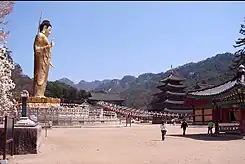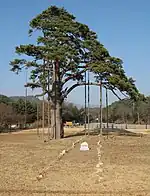Songnisan National Park
Songnisan (속리산) is a national park in South Korea. It contains nine mountain peaks, located in the center of the Sobaek Mountain range.[1] The park lies on the border between the provinces Chungcheongbuk-do and Gyeongsangbuk-do. It has an area of 274.541 square kilometres (106.001 sq mi) and was designated as Korea's sixth national park in 1970.[1][2]
| 속리산국립공원, 俗離山國立公園 | |
|---|---|
| Songnisan National Park | |
 View of Songnisan from the mountain peak Munjangdae. | |
| Coordinates | 36°32′N 127°54′E |
| Area | 274.541 km2 (106.001 sq mi) |
| Established | 24 March 1970 |
| Governing body | Korea National Park Service |
| Songnisan National Park | |
| Hangul | |
|---|---|
| Hanja | |
| Revised Romanization | Songnisan Gungnipgongwon |
| McCune–Reischauer | Songnisan Kungnipkongwŏn |
History

According to Korean legend, Songnisan received its name during the period of Silla, when a monk named Jinpyoyulsa passed some farmers on his way up one of the mountains to the Buddhist temple Beopjusa (법주사). The farmers supposedly witnessed their oxen bowing their heads to him out of repentance. This incident inspired them to follow him to the temple to practice Buddhism themselves, and from then on the mountains were called Songnisan, or "mountain to leave the world."[3]
Prior to this time, it had been referred to simply as Gubongsan (구봉산), meaning "nine peak mountain."[4][5]
Features

The park's most popular attraction is Beopjusa. It is one of Korea's largest Buddhist temples and was initially constructed in 553.[4][6] They can also visit Jeongipumsong (정이품송), a pine tree known for having been awarded a political title by King Sejo in a famous folk tale.[7]
Songnisan is home to a diverse set of wildlife, including mandarin ducks, otters, small-eared cats, martens,[2] and black woodpeckers.[5] Additionally, two endangered species live in the park - the Siberian flying squirrel and the Korean Berchemia, or buckthorn tree.[8][9] Visitors who want to explore more of the park's scenery can hike along one of its many trails.
References
- "Songnisan National Park". Global Alliance of National Parks (GANP official park page). Retrieved October 14, 2023.
- "Songnisan - Introduction". Korea National Park Service. Retrieved October 13, 2023.
- "Legend". Korea National Park Service. Retrieved October 13, 2023.
- "Beopjusa Temple and Surroundings in Songnisan Mountain". Cultural Heritage Administration (Entry in the Heritage Search database, classified as a scenic site). Retrieved October 13, 2023.
- "Beopjusa Temple - Natural Environment of Songnisan Mountain". Sansa, Buddhist Mountain Monasteries in Korea. Jogye Order of Korean Buddhism. Retrieved October 14, 2023.
- "Boeun Beopjusa Temple [UNESCO World Heritage] (보은 법주사 [유네스코 세계문화유산])". Visit Korea. Korea Tourism Organization. Retrieved October 14, 2023.
- "Jeongipum Pine Tree". Korea Tourism Organization. Retrieved 12 May 2017.
- "Flagship Species". Korea National Park Service. Retrieved October 13, 2023.
- "Korean Berchemia of Songnisan, Boeun (보은 속리산 망개나무)". Cultural Heritage Administration (Entry in the Heritage Search database, classified as natural monument). Retrieved October 13, 2023.
External links
 Media related to Songnisan National Park at Wikimedia Commons
Media related to Songnisan National Park at Wikimedia Commons https://en.wikivoyage.org/wiki/Songnisan_National_Park travel guide from Wikivoyage
https://en.wikivoyage.org/wiki/Songnisan_National_Park travel guide from Wikivoyage